check engine YAMAHA XJ600N 2001 Owners Manual
[x] Cancel search | Manufacturer: YAMAHA, Model Year: 2001, Model line: XJ600N, Model: YAMAHA XJ600N 2001Pages: 104, PDF Size: 11.3 MB
Page 23 of 104
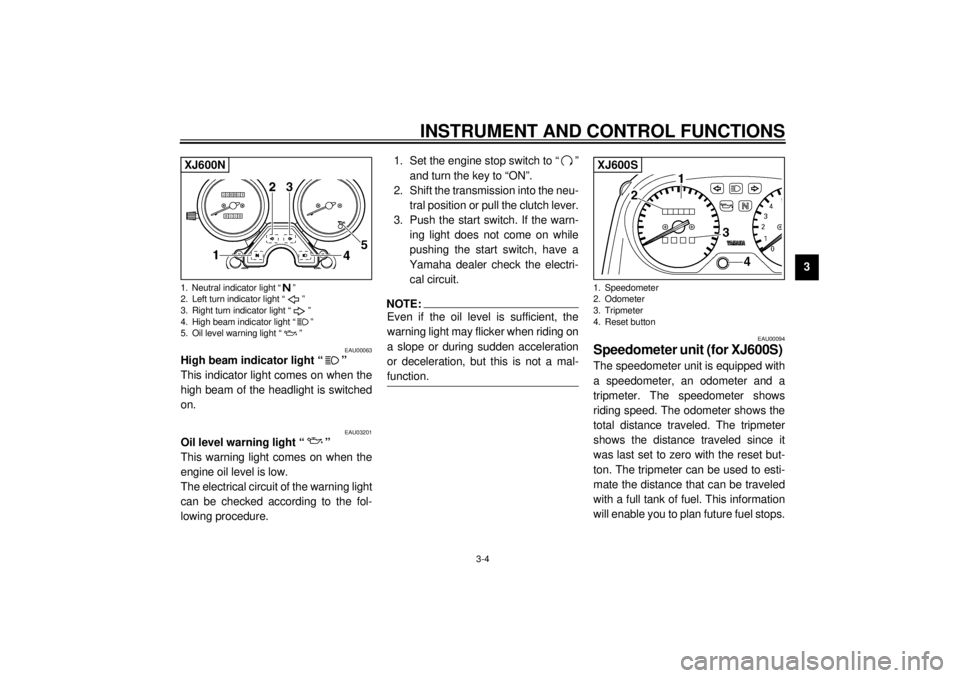
INSTRUMENT AND CONTROL FUNCTIONS
3-4
3
EAU00063
High beam indicator light “ ”
This indicator light comes on when the
high beam of the headlight is switched
on.
EAU03201
Oil level warning light “ ”
This warning light comes on when the
engine oil level is low.
The electrical circuit of the warning light
can be checked according to the fol-
lowing procedure.1. Set the engine stop switch to “ ”
and turn the key to “ON”.
2. Shift the transmission into the neu-
tral position or pull the clutch lever.
3. Push the start switch. If the warn-
ing light does not come on while
pushing the start switch, have a
Yamaha dealer check the electri-
cal circuit.
NOTE:@ Even if the oil level is sufficient, the
warning light may flicker when riding on
a slope or during sudden acceleration
or deceleration, but this is not a mal-
function. @
EAU00094
Speedometer unit (for XJ600S) The speedometer unit is equipped with
a speedometer, an odometer and a
tripmeter. The speedometer shows
riding speed. The odometer shows the
total distance traveled. The tripmeter
shows the distance traveled since it
was last set to zero with the reset but-
ton. The tripmeter can be used to esti-
mate the distance that can be traveled
with a full tank of fuel. This information
will enable you to plan future fuel stops.
1. Neutral indicator light “ ”
2. Left turn indicator light “ ”
3. Right turn indicator light “ ”
4. High beam indicator light “ ”
5. Oil level warning light “ ”XJ600N
1. Speedometer
2. Odometer
3. Tripmeter
4. Reset buttonXJ600S
E_4br.book Page 4 Thursday, August 17, 2000 11:29 AM
Page 29 of 104

INSTRUMENT AND CONTROL FUNCTIONS
3-10
3
EAU01183
Fuel Make sure that there is sufficient fuel in
the tank. Fill the fuel tank to the bottom
of the filler tube as shown in the illustra-
tion.
EW000130
WARNING
@ l
Do not overfill the fuel tank, oth-
erwise it may overflow when the
fuel warms up and expands.
l
Avoid spilling fuel on the hot
engine.
@
EAU00185
CAUTION:@ Immediately wipe off spilled fuel
with a clean, dry, soft cloth, since
fuel may deteriorate painted surfac-
es or plastic parts.@
EAU00191
NOTE:@ If knocking (or pinging) occurs, use
gasoline of a different brand or with a
higher octane grade. @
EAU00196
Fuel tank breather hose
(for Germany only) Before operating the motorcycle:l
Check the fuel tank breather hose
connection.
l
Check the fuel tank breather hose
for cracks or damage, and replace
it if damaged.
l
Make sure that the end of the fuel
tank breather hose is not blocked
and clean it if necessary.
1. Fuel tank filler tube
2. Fuel level
Recommended fuel:
Regular unleaded gasoline with a
research octane number of 91 or
higher
Fuel tank capacity:
Total amount:
17.0 L
Reserve amount:
3.5 L
1. Fuel tank breather hose
E_4br.book Page 10 Thursday, August 17, 2000 11:29 AM
Page 35 of 104

INSTRUMENT AND CONTROL FUNCTIONS
3-16
3
EAU00332
Ignition circuit cut-off system The ignition circuit cut-off system (com-
prising the sidestand switch, clutch
switch and neutral switch) has the fol-
lowing functions.l
It prevents starting when the trans-
mission is in gear and the side-
stand is up, but the clutch lever is
not pulled.
l
It prevents starting when the trans-
mission is in gear and the clutch
lever is pulled, but the sidestand is
still down.
l
It cuts the running engine when
the sidestand is moved down.
Periodically check the operation of the
ignition circuit cut-off system according
to the following procedure.
EW000046
WARNING
@ l
The vehicle must be placed on
the centerstand during this in-
spection.
l
If a malfunction is noted, have a
Yamaha dealer check the sys-
tem before riding.
@
E_4br.book Page 16 Thursday, August 17, 2000 11:29 AM
Page 36 of 104
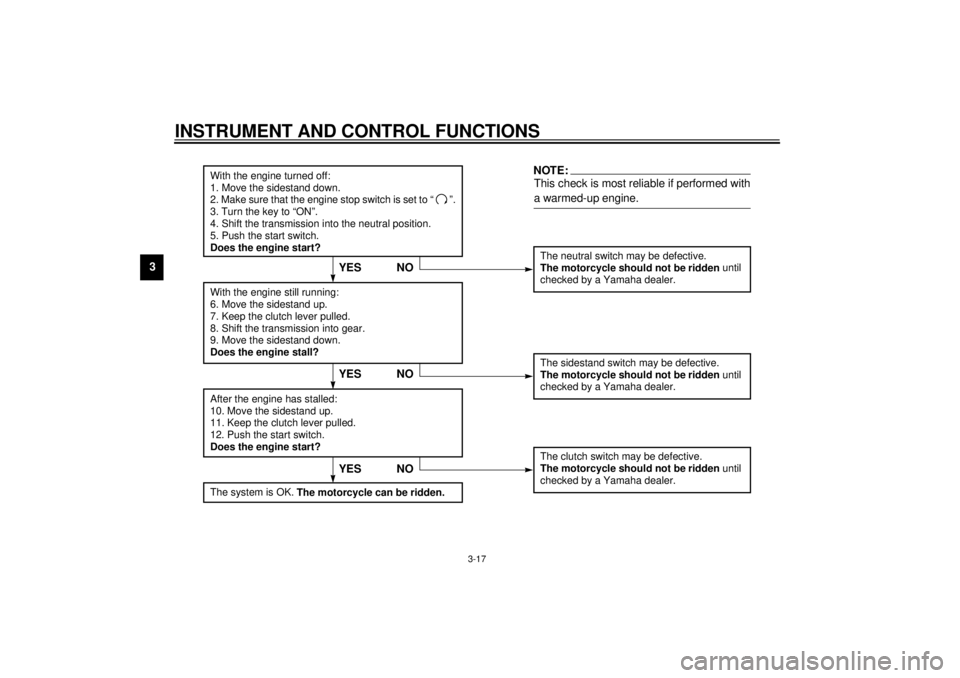
INSTRUMENT AND CONTROL FUNCTIONS
3-17
3
CD-01E
With the engine turned off:
1. Move the sidestand down.
2. Make sure that the engine stop switch is set to “ ”.
3. Turn the key to “ON”.
4. Shift the transmission into the neutral position.
5. Push the start switch.
Does the engine start?
The neutral switch may be defective.
The motorcycle should not be ridden until
checked by a Yamaha dealer.
With the engine still running:
6. Move the sidestand up.
7. Keep the clutch lever pulled.
8. Shift the transmission into gear.
9. Move the sidestand down.
Does the engine stall?After the engine has stalled:
10. Move the sidestand up.
11. Keep the clutch lever pulled.
12. Push the start switch.
Does the engine start?
The sidestand switch may be defective.
The motorcycle should not be ridden until
checked by a Yamaha dealer.The clutch switch may be defective.
The motorcycle should not be ridden until
checked by a Yamaha dealer.
NO
NOTE:This check is most reliable if performed with
a warmed-up engine.
YESYES NO
The system is OK.
The motorcycle can be ridden.
YES NO
E_4br.book Page 17 Thursday, August 17, 2000 11:29 AM
Page 38 of 104

4-1
4
EAU01114
4-PRE-OPERATION CHECKSThe condition of a vehicle is the owner’s responsibility. Vital components can start to deteriorate quickly and unexpectedly,
even if the vehicle remains unused (for example, as a result of exposure to the elements). Any damage, fluid leakage or loss
of tire air pressure could have serious consequences. Therefore, it is very important, in addition to a thorough visual inspec-
tion, to check the following points before each ride.
EAU03328
Pre-operation check list
ITEM CHECKS PAGE
Front brake
• Check operation, fluid level and fluid leakage.
• Fill with DOT 4 brake fluid if necessary.6-19–6-21
Rear brake6-18–6-21
Clutch• Check operation, condition and free play.
• Adjust if necessary.6-17–6-18
Throttle grip and housing• Check smooth operation.
• Lubricate if necessary.6-13, 6-24
Engine oil• Check oil level.
• Fill with oil if necessary.6-7–6-10
Drive chain• Check chain slack and condition.
• Adjust if necessary.6-21–6-23
Wheels and tires• Check tire pressure, wear and damage.6-14–6-17,
6-33–6-36
Control and meter cables• Check smooth operation.
• Lubricate if necessary.6-23
Brake and shift pedal
shafts• Check smooth operation.
• Lubricate if necessary.6-24
Brake and clutch lever
pivots• Check smooth operation.
• Lubricate if necessary.6-25
Center and sidestand
pivots• Check smooth operation.
• Lubricate if necessary.6-25
E_4br.book Page 1 Thursday, August 17, 2000 11:29 AM
Page 42 of 104
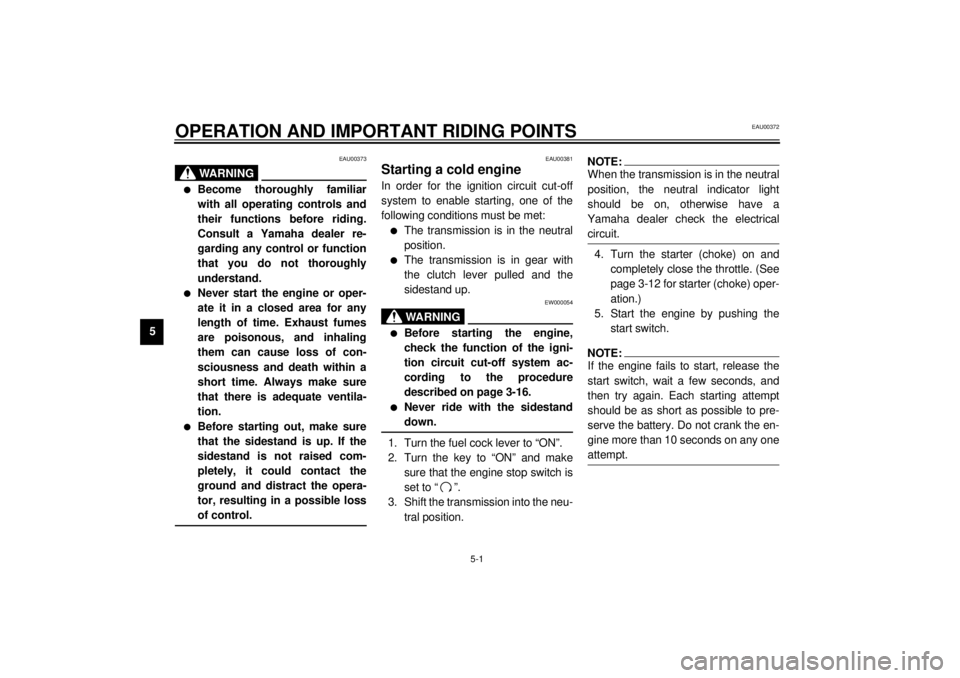
5-1
5
EAU00372
5-OPERATION AND IMPORTANT RIDING POINTS
EAU00373
WARNING
@ l
Become thoroughly familiar
with all operating controls and
their functions before riding.
Consult a Yamaha dealer re-
garding any control or function
that you do not thoroughly
understand.
l
Never start the engine or oper-
ate it in a closed area for any
length of time. Exhaust fumes
are poisonous, and inhaling
them can cause loss of con-
sciousness and death within a
short time. Always make sure
that there is adequate ventila-
tion.
l
Before starting out, make sure
that the sidestand is up. If the
sidestand is not raised com-
pletely, it could contact the
ground and distract the opera-
tor, resulting in a possible loss
of control.
@
EAU00381
Starting a cold engine In order for the ignition circuit cut-off
system to enable starting, one of the
following conditions must be met:l
The transmission is in the neutral
position.
l
The transmission is in gear with
the clutch lever pulled and the
sidestand up.
EW000054
WARNING
@ l
Before starting the engine,
check the function of the igni-
tion circuit cut-off system ac-
cording to the procedure
described on page 3-16.
l
Never ride with the sidestand
down.
@1. Turn the fuel cock lever to “ON”.
2. Turn the key to “ON” and make
sure that the engine stop switch is
set to “ ”.
3. Shift the transmission into the neu-
tral position.
NOTE:@ When the transmission is in the neutral
position, the neutral indicator light
should be on, otherwise have a
Yamaha dealer check the electrical
circuit. @4. Turn the starter (choke) on and
completely close the throttle. (See
page 3-12 for starter (choke) oper-
ation.)
5. Start the engine by pushing the
start switch.NOTE:@ If the engine fails to start, release the
start switch, wait a few seconds, and
then try again. Each starting attempt
should be as short as possible to pre-
serve the battery. Do not crank the en-
gine more than 10 seconds on any one
attempt. @
E_4br.book Page 1 Thursday, August 17, 2000 11:29 AM
Page 43 of 104

OPERATION AND IMPORTANT RIDING POINTS
5-2
5
EC000034
CAUTION:@ The oil level warning light should
come on when the start switch is
pushed, and it should go off when
the start switch is released. If the oil
level warning light flickers or re-
mains on after starting, immediately
stop the engine, and then check the
engine oil level and the vehicle for
oil leakage. If necessary, add engine
oil, and then check the warning light
again. If the warning light does not
come on when pushing the start
switch, or if it does not go off after
starting with sufficient engine oil,
have a Yamaha dealer check the
electrical circuit. @6. After starting the engine, move the
starter (choke) knob/lever back
halfway.
ECA00045
CAUTION:@ For maximum engine life, never ac-
celerate hard when the engine is
cold! @7. When the engine is warm, turn the
starter (choke) off.NOTE:@ The engine is warm when it responds
normally to the throttle with the starter
(choke) turned off. @
EAU01258
Starting a warm engine Follow the same procedure as for start-
ing a cold engine with the exception
that the starter (choke) is not required
when the engine is warm.
E_4br.book Page 2 Thursday, August 17, 2000 11:29 AM
Page 46 of 104
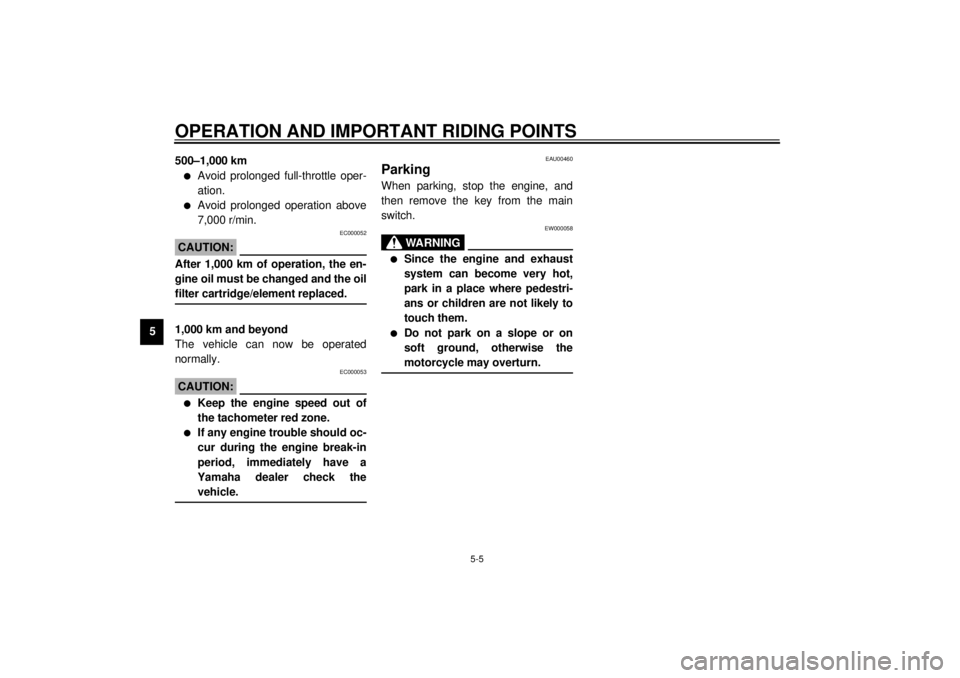
OPERATION AND IMPORTANT RIDING POINTS
5-5
5500–1,000 km
l
Avoid prolonged full-throttle oper-
ation.
l
Avoid prolonged operation above
7,000 r/min.
EC000052
CAUTION:@ After 1,000 km of operation, the en-
gine oil must be changed and the oil
filter cartridge/element replaced. @1,000 km and beyond
The vehicle can now be operated
normally.
EC000053
CAUTION:@ l
Keep the engine speed out of
the tachometer red zone.
l
If any engine trouble should oc-
cur during the engine break-in
period, immediately have a
Yamaha dealer check the
vehicle.
@
EAU00460
Parking When parking, stop the engine, and
then remove the key from the main
switch.
EW000058
WARNING
@ l
Since the engine and exhaust
system can become very hot,
park in a place where pedestri-
ans or children are not likely to
touch them.
l
Do not park on a slope or on
soft ground, otherwise the
motorcycle may overturn.
@
E_4br.book Page 5 Thursday, August 17, 2000 11:29 AM
Page 47 of 104
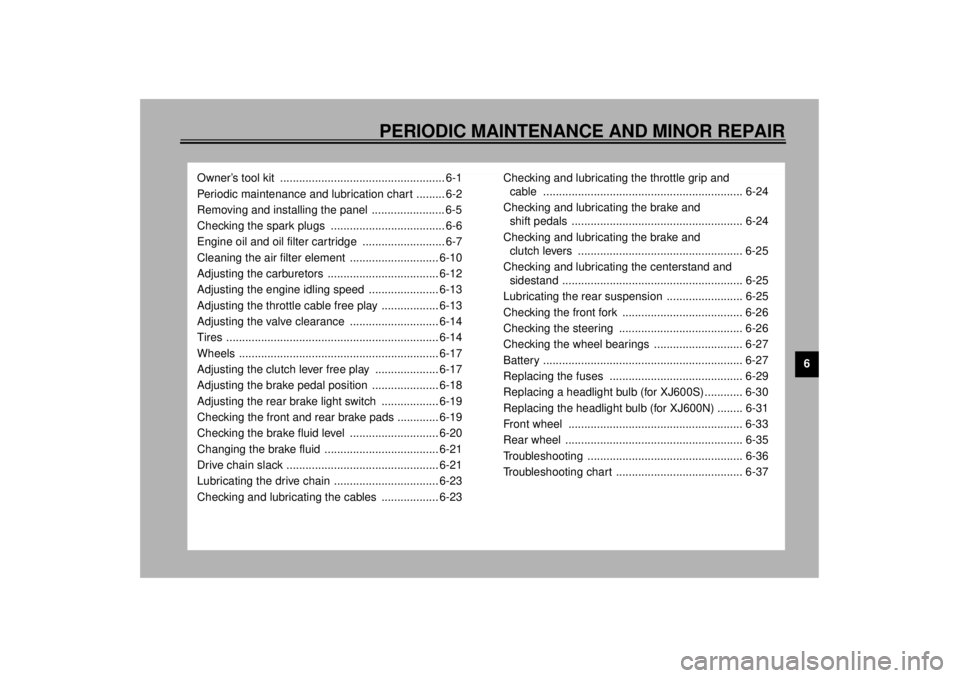
6
PERIODIC MAINTENANCE AND MINOR REPAIR
Owner’s tool kit .................................................... 6-1
Periodic maintenance and lubrication chart ......... 6-2
Removing and installing the panel ....................... 6-5
Checking the spark plugs .................................... 6-6
Engine oil and oil filter cartridge .......................... 6-7
Cleaning the air filter element ............................ 6-10
Adjusting the carburetors ................................... 6-12
Adjusting the engine idling speed ...................... 6-13
Adjusting the throttle cable free play .................. 6-13
Adjusting the valve clearance ............................ 6-14
Tires ................................................................... 6-14
Wheels ............................................................... 6-17
Adjusting the clutch lever free play .................... 6-17
Adjusting the brake pedal position ..................... 6-18
Adjusting the rear brake light switch .................. 6-19
Checking the front and rear brake pads ............. 6-19
Checking the brake fluid level ............................ 6-20
Changing the brake fluid .................................... 6-21
Drive chain slack ................................................ 6-21
Lubricating the drive chain ................................. 6-23
Checking and lubricating the cables .................. 6-23Checking and lubricating the throttle grip and
cable ............................................................... 6-24
Checking and lubricating the brake and
shift pedals ...................................................... 6-24
Checking and lubricating the brake and
clutch levers .................................................... 6-25
Checking and lubricating the centerstand and
sidestand ......................................................... 6-25
Lubricating the rear suspension ........................ 6-25
Checking the front fork ...................................... 6-26
Checking the steering ....................................... 6-26
Checking the wheel bearings ............................ 6-27
Battery ............................................................... 6-27
Replacing the fuses .......................................... 6-29
Replacing a headlight bulb (for XJ600S) ............ 6-30
Replacing the headlight bulb (for XJ600N) ........ 6-31
Front wheel ....................................................... 6-33
Rear wheel ........................................................ 6-35
Troubleshooting ................................................. 6-36
Troubleshooting chart ........................................ 6-37
E_4br.book Page 1 Thursday, August 17, 2000 11:29 AM
Page 50 of 104

PERIODIC MAINTENANCE AND MINOR REPAIR
6-3
6
10
*Wheels• Check runout and for damage.ÖÖÖÖ
11*Tires• Check tread depth and for damage.
• Replace if necessary.
• Check air pressure.
• Correct if necessary.ÖÖÖÖ
12*Wheel bearings• Check bearing for looseness or damage.ÖÖÖÖ
13*Swingarm• Check operation and for excessive play.ÖÖÖÖ
• Lubricate with molybdenum disulfide grease. Every 50,000 km
14 Drive chain• Check chain slack.
• Make sure that the rear wheel is properly aligned.
• Clean and lubricate.Every 1,000 km and after washing
the motorcycle or riding in the rain.
15*Steering bearings• Check bearing play and steering for roughness.ÖÖÖÖÖ
• Lubricate with lithium-soap-based grease Every 20,000 km
16*Chassis fasteners• Make sure that all nuts, bolts and screws are properly tightened.ÖÖÖÖ Ö
17 Sidestand/centerstand• Check operation.
• Lubricate.ÖÖÖÖ Ö
18*Sidestand switch• Check operation.ÖÖÖÖÖ Ö
19*Front fork• Check operation and for oil leakage.ÖÖÖÖ
20*Rear shock absorber
assembly• Check operation and shock absorber for oil leakage.ÖÖÖÖ
21*Rear suspension relay
arm and connecting arm
pivoting points• Check operation.ÖÖÖÖ
• Lubricate with molybdenum disulfide grease.ÖÖ
22*Carburetors• Check starter (choke) operation.
• Adjust engine idling speed and synchronization.ÖÖÖÖÖ Ö
23 Engine oil• Change.ÖÖÖÖÖ Ö
24 Engine oil filter cartridge•Replace.ÖÖÖ NO. ITEM CHECK OR MAINTENANCE JOBODOMETER READING (´1,000 km)
Annual
check
1 10203040
E_4br_Periodic.fm Page 3 Friday, December 15, 2000 9:27 AM